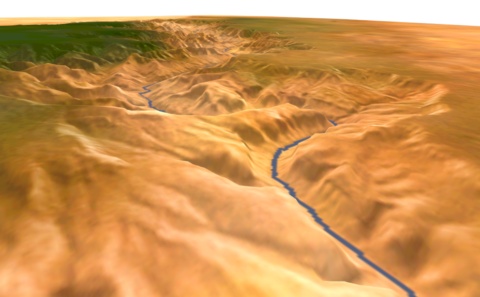Smooth view-dependent level-of-detail control and its application to terrain rendering

Visually smooth adaptation of mesh refinement using cascaded temporal geomorphs.
Abstract:
The key to real-time rendering of large-scale surfaces is to locally adapt surface geometric complexity to
changing view parameters. Several schemes have been developed to address this problem of view-dependent
level-of-detail control. Among these, the view-dependent progressive mesh (VDPM) framework
represents an arbitrary triangle mesh as a hierarchy of geometrically optimized refinement transformations,
from which accurate approximating meshes can be efficiently retrieved. In this paper we extend the general
VDPM framework to provide temporal coherence through the runtime creation of geomorphs. These
geomorphs eliminate "popping" artifacts by smoothly interpolating geometry. Their implementation requires
new output-sensitive data structures, which have the added benefit of reducing memory use.
We specialize the VDPM framework to the important case of terrain rendering. To handle huge terrain grids, we introduce a block-based simplification scheme that constructs a progressive mesh as a hierarchy of block refinements. We demonstrate the need for an accurate approximation metric during simplification. Our contributions are highlighted in a real-time flyover of a large, rugged terrain. Notably, the use of geomorphs results in visually smooth rendering even at 72 frames/sec on a graphics workstation.
We specialize the VDPM framework to the important case of terrain rendering. To handle huge terrain grids, we introduce a block-based simplification scheme that constructs a progressive mesh as a hierarchy of block refinements. We demonstrate the need for an accurate approximation metric during simplification. Our contributions are highlighted in a real-time flyover of a large, rugged terrain. Notably, the use of geomorphs results in visually smooth rendering even at 72 frames/sec on a graphics workstation.
Hindsights:
The runtime geomorphs make this one of my favorite demos.
The irregular meshes reduce the number of triangles for a given level of approximation accuracy, and allow
large regions of the terrain to be pre-simplified.
This approach has been generalized to general (non-terrain) meshes, in
Chris Prince's Masters Thesis
Progressive
Meshes for Large Models of Arbitrary Topology.
In my opinion, for terrains the future lies in regularly sampled representations such as
geometry clipmaps.
See content copyrights.